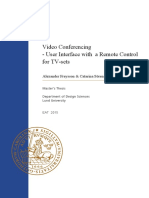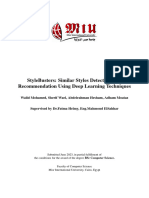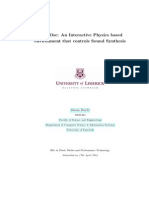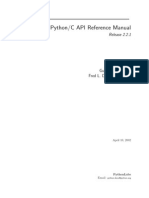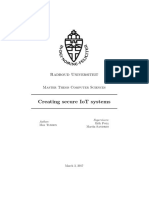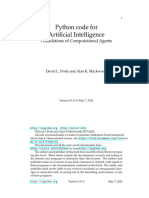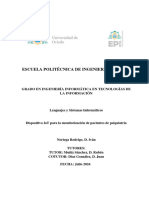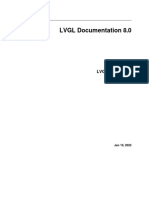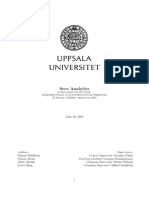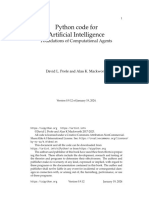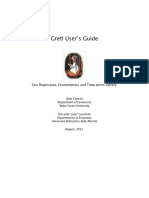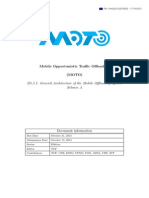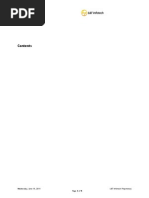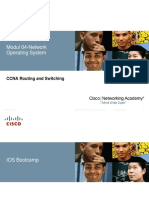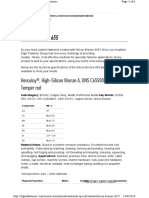0 ratings0% found this document useful (0 votes)
70 viewsFinal Year Project Report: Colin Smith
Final Year Project Report: Colin Smith
Uploaded by
sherii07This document is a final year project report submitted by Colin Smith for a computer science degree. It details the design and implementation of a system called ReFInDer that uses RFID technology to help users locate lost items. The system consists of a mobile component with an RFID reader and microcomputer that collects interaction data, and a website that presents this data to help users remember where they may have misplaced an item. The report describes the background research on related technologies, the system design including hardware and interfaces, testing of the RFID prototype, and conclusions that the system is effective but could be improved with additional information.
Copyright:
© All Rights Reserved
Available Formats
Download as PDF, TXT or read online from Scribd
Final Year Project Report: Colin Smith
Final Year Project Report: Colin Smith
Uploaded by
sherii070 ratings0% found this document useful (0 votes)
70 views37 pagesThis document is a final year project report submitted by Colin Smith for a computer science degree. It details the design and implementation of a system called ReFInDer that uses RFID technology to help users locate lost items. The system consists of a mobile component with an RFID reader and microcomputer that collects interaction data, and a website that presents this data to help users remember where they may have misplaced an item. The report describes the background research on related technologies, the system design including hardware and interfaces, testing of the RFID prototype, and conclusions that the system is effective but could be improved with additional information.
Original Description:
rfid project
Original Title
Smith
Copyright
© © All Rights Reserved
Available Formats
PDF, TXT or read online from Scribd
Share this document
Did you find this document useful?
Is this content inappropriate?
This document is a final year project report submitted by Colin Smith for a computer science degree. It details the design and implementation of a system called ReFInDer that uses RFID technology to help users locate lost items. The system consists of a mobile component with an RFID reader and microcomputer that collects interaction data, and a website that presents this data to help users remember where they may have misplaced an item. The report describes the background research on related technologies, the system design including hardware and interfaces, testing of the RFID prototype, and conclusions that the system is effective but could be improved with additional information.
Copyright:
© All Rights Reserved
Available Formats
Download as PDF, TXT or read online from Scribd
Download as pdf or txt
0 ratings0% found this document useful (0 votes)
70 views37 pagesFinal Year Project Report: Colin Smith
Final Year Project Report: Colin Smith
Uploaded by
sherii07This document is a final year project report submitted by Colin Smith for a computer science degree. It details the design and implementation of a system called ReFInDer that uses RFID technology to help users locate lost items. The system consists of a mobile component with an RFID reader and microcomputer that collects interaction data, and a website that presents this data to help users remember where they may have misplaced an item. The report describes the background research on related technologies, the system design including hardware and interfaces, testing of the RFID prototype, and conclusions that the system is effective but could be improved with additional information.
Copyright:
© All Rights Reserved
Available Formats
Download as PDF, TXT or read online from Scribd
Download as pdf or txt
You are on page 1of 37
Final Year Project Report
Using RFID to Remember
Colin Smith
A thesis submitted in part fullment of the degree of
BA/BSc (hons) in Computer Science
Supervisor: Lorcan Coyle, Aaron Quigley
Moderator: Fintan Costello
UCD School of Computer Science and Informatics
College of Engineering Mathematical and Physical Sciences
University College Dublin
July 18, 2008
Table of Contents
Abstract . . . . . . . . . . . . . . . . . . . . . . . . . . . . . . . . . . . . . . . . 3
1 Introduction . . . . . . . . . . . . . . . . . . . . . . . . . . . . . . . . . . . 5
1.1 Project Specication . . . . . . . . . . . . . . . . . . . . . . . . . . . . . . . 5
2 Background Research . . . . . . . . . . . . . . . . . . . . . . . . . . . . . 7
2.1 Introduction . . . . . . . . . . . . . . . . . . . . . . . . . . . . . . . . . . . . 7
2.2 An Introduction to RFID Technology . . . . . . . . . . . . . . . . . . . . . . 7
2.3 The Computer for the 21st Century . . . . . . . . . . . . . . . . . . . . . . . 8
2.4 Chatchayanusons Kitchen Tracker . . . . . . . . . . . . . . . . . . . . . . . 8
2.5 Ubiquitous Memories . . . . . . . . . . . . . . . . . . . . . . . . . . . . . . . 9
2.6 Schmidt and Gellersens RFID glove . . . . . . . . . . . . . . . . . . . . . . 10
2.7 Intels iGlove . . . . . . . . . . . . . . . . . . . . . . . . . . . . . . . . . . . . 11
2.8 Lustigs RFID glove . . . . . . . . . . . . . . . . . . . . . . . . . . . . . . . . 11
2.9 Activity Recognition . . . . . . . . . . . . . . . . . . . . . . . . . . . . . . . 12
2.10 Recognising Assembly Tasks . . . . . . . . . . . . . . . . . . . . . . . . . . . 12
2.11 Conclusions . . . . . . . . . . . . . . . . . . . . . . . . . . . . . . . . . . . . 13
3 System Design and Implementation . . . . . . . . . . . . . . . . . . . . 15
3.1 Introduction . . . . . . . . . . . . . . . . . . . . . . . . . . . . . . . . . . . . 15
3.2 Problem Analysis . . . . . . . . . . . . . . . . . . . . . . . . . . . . . . . . . 15
3.3 System Form Factor . . . . . . . . . . . . . . . . . . . . . . . . . . . . . . . . 15
3.4 Hardware Design . . . . . . . . . . . . . . . . . . . . . . . . . . . . . . . . . 16
3.5 Data Processing . . . . . . . . . . . . . . . . . . . . . . . . . . . . . . . . . . 19
3.6 User Interfaces . . . . . . . . . . . . . . . . . . . . . . . . . . . . . . . . . . . 20
3.7 Bluetooth . . . . . . . . . . . . . . . . . . . . . . . . . . . . . . . . . . . . . 21
3.8 Full System Overview . . . . . . . . . . . . . . . . . . . . . . . . . . . . . . . 21
4 System Testing and Evaluation . . . . . . . . . . . . . . . . . . . . . . . 23
4.1 Introduction . . . . . . . . . . . . . . . . . . . . . . . . . . . . . . . . . . . . 23
Page 1 of 36
4.2 RFID Prototype . . . . . . . . . . . . . . . . . . . . . . . . . . . . . . . . . . 23
4.3 System Form Factor . . . . . . . . . . . . . . . . . . . . . . . . . . . . . . . . 25
4.4 Human Readable Cues . . . . . . . . . . . . . . . . . . . . . . . . . . . . . . 26
5 Conclusions and Future Work . . . . . . . . . . . . . . . . . . . . . . . . 28
5.1 Conclusions . . . . . . . . . . . . . . . . . . . . . . . . . . . . . . . . . . . . 28
5.2 Future Work . . . . . . . . . . . . . . . . . . . . . . . . . . . . . . . . . . . . 29
A Cue Evaluation Survey . . . . . . . . . . . . . . . . . . . . . . . . . . . . 31
A.1 Introduction . . . . . . . . . . . . . . . . . . . . . . . . . . . . . . . . . . . . 31
B Bluetooth . . . . . . . . . . . . . . . . . . . . . . . . . . . . . . . . . . . . 33
Page 2 of 36
Abstract
RFID has proved to be a useful technology, becoming more common with devel-
opment of applications that benet people in everyday useful ways. This project
demonstrates the use of this technology to aid human memory, specically to help
people nd lost items. Losing a wallet or a mobile phone is a common occur-
rence for most people, and a system such as this could be benecial. The system
consists of an RFID component which identies user interactions with objects.
This data is used to help people locate lost items through interacting with a lost
and found application, which is based on human readable cues. For example,
The user last took their wallet out of their bag at 12:00 along with their car
keys. The cues are constructed based on interactions with such objects. Users
view these cues through a web page and also receive alerts on potentially lost
items through a built in system display. Results of this research indicate that
RFID is a useful and eective technology in such a system. The human readable
cues are found to be eective, however they can be supplemented with additional
information to improve the systems overall eectiveness.
Page 3 of 36
Acknowledgments
A big thank you to Lorcan Coyle, Steve Neely, and Graeme Stevenson. Thanks for all your
help and ideas guys, its really appreciated. Thanks to Caitie Lustig for her work during
ODCSSS and for answering all my questions. Thanks to Colm Mulryan, Olga Murdoch,
Christine Trant, and Oliver van Heteren for their support during the project. Thanks to all
those who participated in the cue evaluation and took the time to ll out the survey.
Page 4 of 36
Chapter 1: Introduction
This report describes the development of the ReFInDer system, which helps users to nd lost
items, such as a phone or wallet. It is based on RFID technology, which is used to record user
interactions with these items. RFID is a way of wirelessly identifying objects, consisting of
a reader and tags. When an item is tagged, it can be uniquely identied when it comes into
range of the reader. Using these records of user interactions with items, a Memory Aid can
be developed. This takes the form of a web site where users can obtain information about
their interactions with a lost item and aid them in remembering where they may have lost it.
ReFInDer consists of a mobile component and a website. The mobile component consists
of the RFID reader connected to a portable micro-sized computer, which has an extremely
small form factor. This gathers information about users interactions such as when they had
certain items. The static component consists of a server and lost and found website. The data
gathered by the micro-computer is wirelessly transmitted to the server, stored in a database,
and presented to the user through the website. The mobile component also incorporates an
LCD screen, facilitating an additional user interface. In addition to the implementation steps
given by the project specication an additional means of gathering information about a users
activities was explored using Bluetooth.
This report presents a detailed overview of the goals, design and outcome of the system
implementation. It includes a full description of the system design and construction leading to
system evaluations and conclusions. Chapter 2 discusses background research relevant to the
project. The papers presented are relevant to the technologies being used and provide useful
insight into related elds of research involving these technologies. The background research
also gives further insight into the applicability and usefulness of RFID for the proposed
system design, and explores the concepts and goals of this project. Chapter 3 gives a detailed
description of ReFInDers implementation. This includes the systems design with regards to
the hardware being used and the systems form factor. This chapter also includes descriptions
of ReFInDers data processing techniques and overviews of the software technologies being
used. Chapter 4 describes how the system is evaluated and tested. This chapter describes
testing which was implemented on the systems key components. Chapter 5 presents the nal
conclusions of this work based upon the overall evaluations and performance of the system.
The applicability of this system for its intended purpose is discussed and the future research
potential for this technology is explored.
1.1 Project Specication
The following is the original specication for this project:
Title: Using RFID to Remember
Lecturer: Lorcan Coyle and Aaron Quigley
Description: Associating interactions between users and artifacts in their everyday surround-
ings could be a useful way of helping people remember where they left them. When people
cannot nd something, simple cues like you left your keys on the dresser table, or i saw you
Page 5 of 36
take your wallet with your mobile phone are naturally helpful. This project seeks to record
a persons interactions with everyday items and generate useful cues to the user when they
lose something.
This project builds on an earlier ODCSSS summer school project, where an RFID reader is
embedded in a glove and RFID tags are attached to kitchen implements. The reader can see
when the user interacts with any item that has an attached tag and know what that item is.
The earlier project recorded interactions with the kitchen implements and used them to detect
when the user was completing a routine task (e.g., making a cup of tea). This project would
have access to the outputs of that project and one of the challenges of this project would be
to understand, reuse, and extend the earlier work.
Mandatory: Software must be built to recognise a human users interactions with everyday
objects. These objects would be attached with RFID tags and the user will interact with
them using the rd glove.
The software must be capable of giving useful (if simple) cues to remind the user where
lost items are, e.g. you interacted with your mobile phone at 2:01pm, 32 seconds after you
interacted with your car keys and 21 seconds before you interacted with your wallet
Discretionary: A useful way for the software to communicate with the user should be de-
veloped - this might be through a lost-and-found web page, or a display attached to the
glove.
Exceptional: More complex, human readable cues should be developed, e.g., you last had
your mobile just after 2pm; you were also using your car keys and wallet at that time.
Page 6 of 36
Chapter 2: Background Research
2.1 Introduction
This chapter presents an overview of background research relevant to the project. Previous
research involving RFID technology is discussed. The literature also explores a number of
relevant concepts such as ubiquitous computing and wearable technology. These papers give
a positive insight into dierent implementations of the proposed technologies, leading to some
important conclusions on the application of RFID technology in this project.
2.2 An Introduction to RFID Technology
RFID is a technique for wirelessly identifying objects, which has become increasingly recog-
nised for its many potential mainstream applications and uses. Examples include retail secu-
rity systems and inventory management. The increase in the use of RFID is due mainly to
lower cost of RFID components and the large amount of potential applications of RFID tech-
nology. Recent research into the applicability of RFID include short range mobile phone com-
munication, and anti counterfeit cryptography and authentication techniques [1, 4]. There
are various types of RFID available, suited to dierent types of applications. From the high-
est level RFID can be divided into two classes, active and passive [1]. The dierence between
them is based on the method in which the tags are powered. Figure 2.1 shows the RFID
reader used in this system and an example tag.
2.2.1 Passive Vs Active RFID
The RFID method used in the ReFInDer system is known as passive RFID [1]. This is opposed
to active RFID where the tags contain their own power source. As these tags are much larger
and will eventually require maintenance such as battery replacement, passive RFID is the
ideal choice. In this technique tags are powered by the reader using a method known as
electromagnetic induction, where tags can build a charge from the readers magnetic eld.
Once powered the tag can transmit its unique hexadecimal ID. Passive RFID tags are much
smaller and exible, thus more suitable for placing on common items. They are unobtrusive
and could, for example, be placed inside the battery cover of a phone. This proves consistent
with the projects main goals.
Page 7 of 36
Figure 2.1: Left) RFID reader used in ReFInDer: measures 62.22mm x 82.5mm, Right)
Example RFID tag: measures 50mm in diameter [14]
2.3 The Computer for the 21st Century
Mark Weisers seminal paper on ubiquitous computing proposes the concept of embodied
virtuality [11]. He describes how in todays world information is everywhere in our environ-
ment, so much so that we do not even notice it. Technology is a common element in our
environment but it has yet to reach its full potential. He conceives a system in which comput-
ers cover free surface spaces in our surroundings, connected through an invisible network, and
become part of our normal environment. One is surrounded by technology, but it vanishes
into the background so as its presence is not noted. Such a system has countless applications.
This is similar to the ideas of Dey et al. [15] in which the concept of technology integrating
and blended seamlessly into our environment is explored. Weisers proposed system identies
people through badges, for example, and adjusts the environment based on the preferences
of the individual. A person enters a room and their calls and messages are automatically
transferred to them through the environment. When a person enters their place of work they
are identied, at which point their oce logs them in and displays documents and les, or
perhaps starts to make coee, before they have even arrived. An important point Weiser
raises is that such complex systems do not require the use of complex articial intelligence
techniques. All these systems can simply be derived from knowing basic information about
a persons activities [11]. This project proposes a similar concept. From knowing simple
information about a users interactions with objects, a more complex and useful application
can be derived.
2.4 Chatchayanusons Kitchen Tracker
Chatchayanuson et al.s Kitchen Tracker system proposes to aid people with grocery shop-
ping [5]. The system consists of stationary RFID readers in a kitchen and tags placed on key
grocery items within it. As items are removed from the kitchen, i.e., used or thrown away,
the RFID readers are used to identify this. The data is used to assist in grocery shopping
Page 8 of 36
indicating key items that are needed in the kitchen through real time synchronisation with
a phone or PDA. These implementations are based on smart home concepts [5]. The system
is an integrated and useful system contained within a home environment, assisting in every
day tasks without being obtrusive to a persons life. An important point raised by this im-
plementation is that such technologies should be unobtrusive and blend naturally into our
environment.
2.5 Ubiquitous Memories
Kawamura et al.s Ubiquitous Memories is an innovative system designed to augment human
memory through interaction with objects, and explores the area of wearable computing [6].
From a hardware perspective the system consists of a head mounted display over the left eye
for displaying videos to the user. This eyepiece also incorporates a camera to record users
activities and experiences. There is an RFID reader on one wrist to read tagged objects.
These are both connected to a remote control for the system which connects to a hip-mounted
wearable computer. This is shown in gure 2.2. This computer connects wirelessly to a LAN.
The system records the users experiences and activities and passes them to a server to be
stored in a video database. Objects related to specic events are RFID tagged. When a tag
is read the system replays a video related to that object, mimicking the behavior of human
memory. When people touch objects they often recall associated memories.
Figure 2.2: Ubiquitous Memories system [6]
The system was tested using memory and recall techniques using dierent memory aids.
This determines the eectiveness of the system in aiding human memory and also oers
insight into alternative ways of achieving this. The system is compared to other memory aid
methods, in this case memory recall techniques that do not involve technology. Instead of
simply rating the system performance based solely on testing it for what it is designed for, it is
compared to these other methods which ultimately have the same goal. This knowledge could
be potentially used to rene or augment the system in the future. It is this authors opinion
that, like the kitchen tracker system and Weisers concepts [5, 11], it is important to point
out that such a system needs to be unobtrusive and feel natural in our environment. This
Page 9 of 36
is particularly relevant for wearable computing in which the user is often in direct physical
contact or in possession of the technology while they undertake everyday tasks.
2.6 Schmidt and Gellersens RFID glove
Like the Ubiquitous Memories system, Schmidt and Gellersens RFID glove explores the area
of wearable computing [6, 10]. In this area there is often diculty in providing computer
input if systems carry high cognitive loads or performance problems in their deployment.
They explore human computer interaction using an RFID based system in an attempt to
overcome the inherent shortcomings of wearable computing. The main concept is based
on implicit human computer interaction. Implicit interaction is described as actions which
are not primarily intended to be used as computer input but can still be used as such in
some useful way. This is very relevant to the implementation of ReFInDer and similar to
Weisers concepts [11], where computer inputs are used to create a useful application. Their
implementation consists of a glove with an integrated RFID reader. Figure 2.3 shows the
system components. The reader is connected through a serial connection to a wearable
computer. Each RFID tag ID is mapped to specic URL, which contains a counter. Each
time an object is identied its corresponding counter is increased. Their test system did not
have a specic task it was simply used to explore the use of RFID in wearable computing
and if it has potential future applications.
They conclude that such an implementation eectively overcomes the traditional problems
associated with user input in wearable computing, and propose that such a system would
form a sound base for implementing practical applications of the technology [10]. Their
work indicates how RFID can overcome high cognitive loads which are typical of wearable
technology, where the technology does not require a users attention or interaction in order
to gather useful computer input and data.
Figure 2.3: RFID glove components (from Schmidt and Gellerson [10]): a) RFID Tags, b)
Reader Coils, c) Wearable Tag Reader
Page 10 of 36
2.7 Intels iGlove
In building useful applications with RFID technology a technique is required in order to
allow the computer to correctly interpret its inputs. Intel Seattles iGlove research project
explored the concept of recognising and interpreting an individuals activities from large sets
of possibly related RFID readings [2]. Like Schmidt and Gellersen, their system prototype
was an RFID enabled glove with the antenna located in the palm. This is connected to a
reader with radio capabilities for communicating with a computer. The glove components
are all housed in a plastic box on the outer side of the glove, which overall makes the system
compact and unobtrusive, which can be seen in gure 2.4.
One diculty their system faced was interpreting variety, for example the same task could
be completed in dierent ways or in a dierent order of steps. This would give various
combinations of data inputs leading to the diculty of interpreting them correctly. The
proposed solution was to represent tasks in a sequence, or probable sequence, of the objects
used, which resulted in a high level of system accuracy and performance. This is shown by
their systems ability to correctly identify various tasks being undertaken by the user [2]. The
ReFInDer system also gathers large amounts of data and similarly to the iGlove may present
inherent diculties in interpreting it correctly, which needed consideration in the systems
data processing techniques.
Figure 2.4: Intels iGlove [1]
2.8 Lustigs RFID glove
Lustig and Coyle developed a similar RFID glove system following Intels work on the
iGlove [2], designed to identify specic tasks carried out by a user [8, 9]. A glove design
was implemented with an RFID reader built into the palm, as shown in gure 2.5. This was
connected to a micro-computer with wireless capabilities. The micro-computer can connect
wirelessly to a server which in turn can update a database of tag reads and pass this infor-
mation to a web page. The system is designed to recognise individual tasks by associating
each one with a number of relevant tags.
This work extends this research building upon the work already achieved while focusing on
a related but dierent goal. Although this project utilised some similar technologies, such as
an RFID reader and micro-computer, the ReFInDer is a very dierent implementation and
dierent application, specically a lost and found application. It also explored a technique of
gathering more data inputs via Bluetooth technology, and more advanced user interaction,
Page 11 of 36
achieved through an LCD display. Having said this it has proven useful to take into account
the results and ndings of their work. It was found that a glove implementation was con-
siderably restrictive to the user, which does not conform to the principles of ubiquitous and
wearable computing, which are some of the main goals of this project. This was considered
a strong motivation for a new proposed form factor.
Figure 2.5: Lustig and Coyles RFID glove [8]
2.9 Activity Recognition
Logan et al. explored the abilities of dierent sensing equipment [12]. This research involved
the use of intels previous research on the iGlove and their later work on the iBracelet [2, 3].
The test system was based on a house equipped with over 900 sensor inputs, such as RFID
tags, current and water ow sensors, and infrared motion detectors. The concept is also
similar Lustig and Coyles RFID glove, in that it uses sensor input to recognise human
interactions and activities in a home environment [8]. In this evaluation the eectiveness of
the sensor types are discussed. In the case of RFID, the user was equipped with an RFID
bracelet for reading tags in the environment, sending tag reads wirelessly to a database. The
results of the experiment showed that RFID performed quite poorly. It was found that this
was due to the reader detecting very few of the objects being touched. There were various
reasons for this, such as opposite hands being used to interact with objects, and temporary
removal of the bracelet for hygiene reasons. This raises a conicting point to the other
implementations, that RFID may not necessarily be useful in some instances. For example, if
a person is washing dishes they cannot have electronic equipment attached to their hands [12].
2.10 Recognising Assembly Tasks
Ward et al. explored the concept of activity recognition and ubiquitous computing [13].
Mobile workers, such as maintenance personnel, often face diculties in accessing useful
information relevant to their task. For example, a person may need to access a PDA to bring
up schematics which requires complete physical and mental attention. The proposed concept
involves identifying users activities and automatically displaying task relevant data through
a head mounted display. This involves both sound and accelerometer sensors, for gesture
identication, to gather data and use dierent algorithmic methods to identify individual
Page 12 of 36
tasks. The arm mounted sensors are shown in gure 2.6. One problem with this, similar to
that of Logan et al., involves non relevant activities [12]. For example, while a user undertakes
a task they may momentarily break from this, perhaps to take something from their pocket.
Their system was tested on a mock scenario where a user constructs a simple item from
wood. Although their results were promising they conclude that their approach would be
more applicable in a home environment, especially with regards to sound identication. They
propose to explore other sensor and algorithmic methods, one of which being RFID, to
improve the performance of the system [13].
Figure 2.6: Arm mounted microphones and accelerometers [13]
2.11 Conclusions
Much of this previous work in RFID applications oers some important guidance and insight
for this project. One important point raised by many of the discussed research papers is
that such systems need to be unobtrusive, feel natural to a user, and blend naturally into
our environment. Ubiquitous Memories and Chatchayanuson et al.s kitchen tracker are good
examples of this, as well as the important concept of ubiquitous computing [5, 6]. Weiser raises
another important point which is relevant to this projects system. From simply knowing some
basic information, such as where you where at a certain time, a more complicated and useful
application can be derived, in this case a memory aid [11].
There are often many problems facing the concept of wearable computing systems, as dis-
cussed by Schmidt and Gellerson, such as problems with performance. While this is true, it
is suggested that RFID oers a sound base for implementing practical applications of these
technologies and overcoming such associated problems [10]. In conict to this, Logan et al.
suggested that RFID may not be useful in some instances, however their evaluation involved
recognition of many, very complex user activities, over a long period of time [12]. In the
instances of low performance involving RFID it seems, in this authors opinion, that the rea-
sons for this could have been taken into account or avoided through revising and augmenting
activity recognition and sensor techniques of the system. The application in this case is also
quite dierent to that of ReFInDer. Identifying a large number of complex tasks as a user
undertakes their everyday home activities involves a high number of random factors, such
as spontaneously switching between tasks. In the proposed system items are static in a cer-
tain sense, where an item is placed in a pocket within very close proximity to the reader.
The possibility of not reading an item in this form factor is low in most cases, as discussed
in section 4.3. It can be concluded that with this systems form factor and design, RFID
technology proves very eective.
Lustig and Coyle found their RFID system to be very restrictive [8]. This project will explore
an alternative form factor in order to overcome these disadvantages. This project will use
Page 13 of 36
some of the proven hardware and technologies as Lustig and Coyles earlier work, such as
the micro-computer and RFID reader, but with a dierent implementation and application.
Their system followed the work of Intel in using RFID to identify a users activities, whereas
this project proposes to gather data on a users interactions with objects. Interaction between
users and the system is augmented using a built in LCD screen to display relevant information.
Page 14 of 36
Chapter 3: System Design and Implementation
3.1 Introduction
Chapter 2 gave an overview of the applicability and suitability of RFID technology to the
areas of wearable and ubiquitous computing. It also highlighted its ability to overcome
the shortcomings inherent to these elds, leading to the conclusion that RFID is a suitable
technology for building the ReFInDer system. This chapter describes how RFID technology
is used in ReFInDer and presents a detailed overview of the ReFInDer systems design.
This includes the systems form factor and the types of hardware used. The systems data
processing techniques are discussed with descriptions of how data is gathered, stored, and
used in the application.
3.2 Problem Analysis
There are two main components required in the ReFInDer system. A mobile component which
is carried by the user and a web based lost and found application. The mobile component is
necessary to gather information about a users interactions with items. It requires the ability
to process and wirelessly transmit this recorded data. The form factor of this component must
be one which is portable and capable of performing its task with minimum user interaction.
The web based component requires a means of receiving and storing recorded data. An
application is needed to retrieve this information and make it accessible to the user. This
application takes the form of the lost and found website and provides a user interface to the
system.
3.3 System Form Factor
The initial concept and form factor of the mobile component was an RFID enabled glove,
inspired by the work of Lustig and Coyle [8]. The major downfall of their system was the
inherent restrictiveness of the gloves design (as discussed in Section 2.8). Also their system
was based upon a very dierent application, recognising user activities, where a glove design
is more suitable for this task. It is also the opinion of this author that an RFID enabled glove
design is very obtrusive to a users everyday activities, and is not consistent with the ideals
of technology blending naturally into our environment.
Another consideration in the design of the systems form factor arised from the initial pro-
totype evaluation. The form factor was inuenced by the inherent limitations of the RFID
readers range. This is discussed further in section 4.2. For these reasons a dierent system
form factor was developed for ReFInDer. This takes the form of a pouch which is placed
inside a pocket with tagged items. A box was designed using a 3D printer to house the mini
Page 15 of 36
Figure 3.1: System Form Factor: Left image shows the front of the pouch with an integrated
LCD display. Right image shows the back of the pouch with RFID reader.
computer. This box along with the RFID reader and batteries are held within the pouch.
The prototype ReFInDer pouch measures 10.5cm x 11cm, and is 2.5cm thick. Its weight is
0.35kg. It is made of cloth and contains a zip at the bottom which facilitates the removal
of the internal components for battery replacement. A switch is also found inside the zip
for powering on and o the system. The front side of the pouch features the LCD display
and the back side of the pouch has a clear plastic covering to show the RFID reader. This
pouch is carried easily within a pocket or a bag. Due to the limited capacity of pockets and
bags the reader will be constantly in close proximity to tagged items. The goal of this is to
overcome the limitations of the readers range. To evaluate and test this design, the pouch
was placed in a bag and jacket pocket with tagged objects. The purpose of this evaluation
was to determine if tagged objects could be successfully identied using this system form
factor. These evaluations are discussed further in section 4.3
3.4 Hardware Design
There are a number of key hardware components required for the ReFInDer system. The
mobile component of ReFInDer consists of an RFID reader connected to a Gumstix com-
puter
1
. The Gumstix is a mini computer running a Linux operating system. The Gumstix is
expanded with wireless capabilities, two serial connections, and has an integrated Bluetooth
module. Expanding the Gumstix involves using expansion boards which simply click onto the
Gumstix. The rst board is known as a Wistix which gives the Gumstix wireless capabilities
and the second board contains two serial port connections. Figure 3.2 shows these compo-
nents. The Gumstix facilitates the necessary data processing and wireless transmission of
recorded data required by the mobile component. It is responsible for gathering information
about a users interactions with objects and transmitting this data wirelessly to the lost and
found application. Information about a users interactions is gathered using the RFID reader,
which detects when the user is in possession of specic tagged objects (step 1 in gure 3.5).
To connect the reader to the Gumstix a small circuit is constructed which regulates a 5V
power supply for the reader and relays tag reads to the Gumstix through one of its serial
ports. Figure 3.3 shows the schematic for this circuit. Figure 3.4 shows the circuit and the
RFID reader connected to the Gumstix.
1
Gumstix information can be found here: www.gumstix.com
Page 16 of 36
Figure 3.2: A) Gumstix, B) Serial port expansion board, C) Wistix, D) Gumstix connected
to Wistix and Serial expansion board
Figure 3.3: Left) Serial to RFID reader circuit schematic, Right) Serial to LCD circuit
schematic
3
Once an RFID tag comes into range of the reader and its ID is read successfully, the ID is
taken in by the Gumstix. The Gumstix then transmits this ID wirelessly to a server where
it can be stored in a database (step 2 in gure 3.5). The function of the server is to host the
online lost and found website and a database. The database stores the information which
has been wirelessly transmitted by the Gumstix (step 3 in gure 3.5). The server runs on a
laptop connected to a router. This allows the Gumstix to be congured to connect to the
router and use it to transmit data to the server and store it in the database.
Connected to the Gumstix is a 32 character LCD screen. The purpose of this is to enhance
the user to system interaction. The LCD connects to one of the Gumstixs serial ports. The
LCD screen is connected to the serial port via a second circuit. This circuit regulates a 5V
power supply to power the LCD screen. Figure 3.3 shows the schematic for this circuit. The
Gumstix transfers data through this circuit which is displayed on the screen as text. Based
on objects that have been identied by the RFID reader, the LCD continues to display the
3
More information Serial to RFID schematic can be found here: http://forums.parallax.com/forums/
default.aspx?f=21&m=180521
Page 17 of 36
Figure 3.4: Left) RFID reader to serial circuit, Right) Gumstix connected to RFID reader
Figure 3.5: System Architecture: 1) Gumstix connected to RFID reader and LCD, 2) Router
wirelessly receives data from Gumstix, 3) Laptop server hosting database and Lost and Found
website
last time the user had certain items. Although this information is not as detailed as that
presented through the lost and found website, it oers the user assistance in situations where
a computer is unavailable. Figure 3.5 shows the system architecture.
Page 18 of 36
3.5 Data Processing
ReFInDer requires a server used to host the Lost and Found website and database. The server
setup used in this project is known as Linux Apache MySQL PHP (LAMP). The LAMP server
system consists of a number of open source software technologies which are commonly used
together in server applications. It consists of an Apache server
4
, MySQL
5
for managing
databases, and PHP
6
scripting language used for server side data processing in dynamic web
pages. These technologies are running on a Linux operating system. The LAMP system was
chosen as it encapsulates the required software technologies for the lost and found application.
MySQL facilitates the storage and retrieval of tag read data which is transmitted to the server
by the mobile component. This data is stored in a MySQL database. The Apache server
hosts the webpages which are written in PHP. Using PHP allows interaction with the MySQL
database, such as storing and retrieving data, and processes this information displaying it to
the user through the website. See gure 3.6 for a data ow diagram.
Figure 3.6: Data Flow Diagram
4
Apache website: http://www.apache.org/
5
MySQL website: www.mysql.com
6
PHP website: http://www.php.net/
Page 19 of 36
When the Gumstix is powered and boots up, it runs a Python script. The Python script is
responsible for transmitting tag IDs to the server which have been read by the RFID reader.
It is also responsible for displaying information on the LCD screen. When a tagged object
is read by the RFID reader, its ID is passed through the serial port to the Gumstix, (step
1 in gure 3.6). This ID is taken in by the Python script. The Python script can then
transmit this ID to a PHP page running on the LAMP server. This PHP page is responsible
for storing the tag ID in the database. When a tag is read, its ID is transmitted wirelessly
via the router to the PHP page, (step 2 and 3 in gure 3.6). This ID is stored in a database
using MySQL queries embedded within the PHP page. Each ID is given a time stamp when
it is stored, consisting of the current time and date. When storing a tag ID it is necessary to
establish what item the ID corresponds to. Each item that can be identied by the system,
such as a phone, has its own unique ID. When storing a new tag ID it is checked against
a second database. The second database stores all tag IDs recognised by the system and
what item the ID corresponds to. When a tag ID is stored, this information is used to
determine which item the ID belongs to and store the corresponding item name with the
tag ID, (step 4 in gure 3.6). For example, the tag ID 04162B761F is received by the
server and PHP page. This ID is checked against the second database which indicates that
04162B761F corresponds to phone. This ID can then be stored with its item name and is
given a timestamp.
Each time a tag ID is read on the Gumstix, the Python program stores the last occurance
of the item. Each time an object is identied its timestamp is updated, so that the system
records when you last had that object. Using this information, the Python script sends this
data to the LCD screen and displays it in the form of a simple cue (step 5 in gure 3.6).
3.6 User Interfaces
With RFID data stored, a PHP website can incorporate this as part of the lost and found
application. When a user loses an item they simply logon to this website and select the item
they are looking for. Using PHP with MySQL the website can retrieve relevant information
from the database. This data is presented to the user aiding them in remembering when and
where they last had the item (step 6 and 7 in gure 3.6). One of the goals for this system
is to return this information in the form of human readable cues, or in such a way that is as
close as possible to human readable language. For example, You last had your wallet at two
o clock. At this time you were also interacting with your keys. This is achieved within the
PHP pages, formatting and ltering data, and displaying relevant information in the form of
the human readable cues. The aim of using human readable cues is to create an application
which people can easily relate to. It is the opinion of this author that a person can better
relate to natural human language rather than lists of data consisting of dates, times and
IDs. The user can read a simple line of text rather than deciphering lists of data in order to
obtain useful information. This however may not always be true. The eectiveness of the two
data representations, human readable cues and a more technical representation, is discussed
in chapter 4. Based on the information obtained from these evaluations the lost and found
application presents data in both forms. Figure 3.7 shows a screen shot from the web site,
which displays an example of the human readable cues.
The second means of presenting useful information to the user is through the LCD screen
built into the mobile component. The LCD continues to display the last time you had
certain items. Due to the LCDs limited screen space, consisting of 32 characters, the cues
are simpler than those found on the lost and found website, for example, Last had phone @
17:38, 17/04/2008. A second limitation with the screen is that users cannot interact with it.
Page 20 of 36
Figure 3.7: Lost and Found website
They do not have control over the information which is displayed, the system simply cycles
through available information. While there are limitations to the LCD screen, the presented
information still facilitates user assistance in the situation where a computer is unavailable.
3.7 Bluetooth
An alternate method of gathering information about a users activities was explored using
Bluetooth. The Gumstix incorporates a built in Bluetooth module which could potentially be
used to augment the systems current functionality. The goal of this was to use the Bluetooth
module to scan for mobile phone Bluetooth IDs. These IDs could be used to represent people
the user has come in contact with. The idea behind gathering this data is to increase the
amount of information given to the user through the Lost and Found website. By giving the
user more information about their activities, the system could potentially be more eective
at helping the user locate an item. In exploring this concept the technology proved ineective
(see appendix B for a discussion of this).
3.8 Full System Overview
The goal of this work is to design and create a Lost and Found application which helps
people locate lost items. Two main components are required to achieve this. A mobile
component and the Lost and Found application. The mobile component is carried by the
user and is responsible for gathering information about a users interactions with items.
To gather this information the mobile component requires a means of retrieving data and
Page 21 of 36
wirelessly transmitting it to the Lost and Found Application. Using RFID technology the
mobile component can identify when the user has specic items. Items can be identied by
placing an RFID tag on them which can be read by the RFID reader. The Gumstix computer
facilitates the retrieval of tag IDs from the RFID reader and wirelessly transmitting them
to the Lost and Found application running on a server. A Python script running on the
Gumstix is responsible for reading in tag IDs from the reader and transmitting them to the
server.
The Lost and Found application consists of a website and database hosted on the server.
This website is used to view information about lost items. When a tag ID is transmitted by
the Gumstix to the server it is stored in the database. When storing a tag ID in the database
it is given a timestamp, consisting of the current date and time, and an item name. The
item name indicates what item the ID corresponds, such as a wallet. The website retrieves
information from this database and displays it to the user in the form of cues, such as You
last had your keys at a quarter past ve. At this time you had your phone. Retrieving
information from the database and displaying it in the form of cues is achieved using PHP
and MySQL.
Page 22 of 36
Chapter 4: System Testing and Evaluation
4.1 Introduction
The ideal evaluation for the ReFInDer system would be a longitudinal study as done by
Logan et al. [12], which involved a house rigged with dierent sensing equipment. This study
resulted in a lot of data and took weeks for full evaluation. For ReFInDer this would involve
a user trial in which a person uses the system for a long period of time and the systems
performance is evaluated over this period. Due to the fact that ReFInDer is currently a
proof of concept prototype, which can only be self powered for short periods of time from 9V
batteries. For any eective long term evaluation the system must be kept plugged into the
mains, which is completely impractical for a full user trial. Also due to the fact that there is
currently only one prototype and a lack of resources to eectively carry out such a trial, the
next best evaluation process has been taken. Individual testing has been undertaken in each
of the ReFInDer systems key components.
4.2 RFID Prototype
Early system testing began with a working prototype implementing the RFID component.
This consisted of the RFID reader connected to the Gumstix, setup of the LAMP server,
and implementation of a simple testing website. This prototype was designed to evaluate
a number of key components of the system. The circuit built for relaying tag IDs to the
Gumstix serial port included an LED, which was used to indicate when tags were being read
successfully. To ensure tag read data was being transferred successfully to the server a simple
test page was setup, which retrieved the contents of the database and displayed it on screen.
The evaluation consisted of placing tags near the RFID reader and moving it slowly closer
along a ruler. This was tested using the front, back, and sides of the reader, with 20 readings
taken for each. The goal of this was to determine if items could be identied with their ID
successfully transmitted to the database. The ruler was used to evaluate the range limitations
of the reader, indicating at what distances tags could be accurately read.
Three tag types were used in this evaluation. The rst tag was a rectangular shape measuring
54mm x 85.5mm and is 0.8mm thick, which are identical dimensions to most credit cards. The
RFID readers documentation indicates that this tag should have an average readable range
of approximately 6.3cm. The documentation indicated that this measurement was based on
positioning the face of the tag parallel to the front or back face of the reader. The second tag
was a circular shape measuring 50mm in diameter and 2.1mm thick. The suggested readable
range for this tag was 6.8cm. The last tag was also circular measuring 25mm in diameter and
1mm thick, roughly the size of a one euro coin. There was no suggested readable range for
this tag type. Figure 4.2 shows the three tag types used in the evaluation. Figure 4.1 shows
a photo of the evaluation and the php test page.
Page 23 of 36
Figure 4.1: RFID Prototype Evaluation: Left) RFID reader and 50mm circular tag, Right)
Screenshot of testing webpage
Figure 4.2: RFID Tags: Left) Rectangular Tag, Center) Circular Tag (50mm), Left) Circular
Tag (25mm) [14]
4.2.1 Results
Table 4.1 shows the results from the evaluation of the RFID readers range. It shows the
mean readable range of each tag type for the front, back, and sides of the RFID reader. For
each of the front, back, and sides, the standard deviation (SD) of the obtained results are
given.
Table 4.1: RFID Reader Evaluation Results
Tag Type Front SD Back SD Sides SD
Rectangular Tag 6.5cm 0.5 6.3cm 0.4cm 3.3cm 0.4cm
Circular Tag: 50mm 8.9cm 3.2cm 8.2cm 1.9cm 3.9cm 2.2cm
Circular Tag: 25mm 3.3cm 0.3cm 2.8cm 0.4cm 1.2cm 0.4cm
The results of this evaluation highlighted the limitations of the RFID readers range. However
it was found that once a tag is within this range it is accurately identied. Viewing the test
page, which displayed the contents of the database, indicated that once an ID is read, it
is always transmitted and stored correctly in the database. This was conrmed using the
testing webpage and the LED light incorporated into the circuit which connects the RFID
reader to the Gumstix. The LED ashes to indicate that the circuit is receiving data. The
testing webpage displays the contents of the database. Viewing this webpage indicated that
the tag reads had been successfully transmitted and stored in the database. This indicates
Page 24 of 36
that the hardware setup and data processing techniques are sound, however the readers range
needed to be considered.
4.3 System Form Factor
The goal of the systems form factor is to create a system which is small, compact and easily
carried by the user. The second factor in its design was to address the limitations of the
readers range. A small pouch design can be placed within a pocket or bag along with other
items. Due to the relatively small space of pockets and bags, items are in close proximity to
each other at all times. The aim of this test was to determine if this design can overcome the
readers limitations.
Although the system is very compact and portable it is necessary to highlight that it is a
proof of concept. If such a system was designed and built commercially it would be con-
siderably smaller and lighter. For example the Gumstix computer is much more powerful
than is necessary for the data processing involved in the system. The circuits involved for
connecting components could be constructed using printed circuit boards which would also
be considerably smaller in size. The weight of the form factor is mainly due to the two 9V
batteries it contains. Again a commercially built system could feature a smaller and lower
weight battery.
This evaluation involved placing the pouch inside the pocket of a bag and a jacket. Tagged
objects were placed in the pocket with the pouch in dierent combinations and positions
in order to determine if they could be identied successfully. Tagged objects consisted of a
wallet, phone and a set of keys. The RFID reader is positioned at the back of the pouch,
as seen in gure 3.1. For this reason it was necessary to evaluate its eectiveness at reading
tags from both the front and back of the pouch. In the evaluation the pouch was tested 30
times for each side.
4.3.1 Results
The results of the form factor evaluation were promising but also highlighted a potential
weakness in its design. When placed in a pocket, ReFInDer successfully identied tagged
items 27 out of 30 tests as long as the reader was facing toward them. If the pouch was
positioned the wrong way around it was found that the system was less eective, with 12 of
30 tests identifying a tagged item. These results indicate that the form factor is very eective
when used in a specic way, however if the pouch was placed in a pocket incorrectly it is
considerably less accurate.
To evaluate the form factor it was placed in both a bag and a jacket pocket. The bag provided
ample space to t the ReFInDer system along with a number of items however when placed
in a jacket pocket the extra space was limited. It was not possible to comfortably t more
than one or two small tagged item in the pocket with the pouch.
Page 25 of 36
4.4 Human Readable Cues
To evaluate the human readable cues a survey was created to gather feedback on which
technique people consider more eective, the human readable cues or raw data consisting of
date and time stamps. This was issued to 13 third year computer science students who had
no direct association with the project. To eliminate the possibility that computer science
students may have a certain bias toward more complicated and detailed data, based on their
experience with working with this type of data, the survey was also issued to 10 non computer
science students. See appendix A for the survey.
4.4.1 Results
The results from the survey showed much similarity in peoples opinions of each data rep-
resentation. Strong conclusions could therefore be drawn from the results and were used
to inuence how data is presented on the lost and found website. In the survey basic cues
consisted of lists of time stamps and the corresponding item that you had at this time, e.g.,
2008-04-01 16:51:31: key. See gure 4.3 for an example of the two data representations. The
survey indicated a number of advantages and disadvantages with this data representation. 12
out of 13 computer science students considered there to be disadvantages with this represen-
tation. Responses included: This could be seen as too much eort to decipher, Its not very
easy to understand, Slightly dicult to read since its just a list of numbers, Could take
a while to interpret and draw conclusions, Its a lot of data. Some users might feel this is
overwhelming, Hard to read for someone not used to it, From a user point of view, I would
rather see a simple line of text than read lines of date/time/item, Its long and not very
personal. Of the 12 participants who considered there to be disadvantages of this format, 10
out of 12 considered this format dicult to read or time consuming to interpret the results.
Results were similar from the 10 non computer science students. 10 out of 10 participants
considered there to be disadvantages with this data type. Responses included, Potentially
complicated, Didnt really understand it at rst, Might be hard to follow if there is lots of
things, Its a little hard to read.
Figure 4.3: Cue Formats: Left) A: Basic cues, Right) B: Human readable cues
Advantages were oered in 12 out of 13 computer science students. Responses included, The
sequence of events is easy to see, Could be used to map patterns to the usual places where
you keep something, Gives all the information, Precise, It shows multiple interactions
with one item, You can see more information. Of these 12 participants 6 considered this
representation more precise or informative, 5 of the 12 participants felt more detailed infor-
mation about a users activities could be derived. 8 out of 10 non computer science students
considered there to be advantages of this data representation. Responses included, More
detailed, Theres a lot more information, Concise, Not too hard after you look at it a few
times.
Page 26 of 36
With regards to the more human readable cues, participants were again asked the advantages
and disadvantages of this format. An example of this format is, You last had your wallet at
ten minutes to four. At this time you also had your keys and phone. Of the 13 computer
science students 11 considered there to be disadvantages, this included, Not as precise,
Doesnt show surrounding events, Not very precise, can seem vague, Not as much times
shown, Lacks the amount of information provided in A. The advantages of this format were
found to be very similar. Responses included, Much more straightforward, easier to obtain
required info, Much easier to read than A, B has a personal touch, it would be a lot easier
to read, Very basic, straightforward, easy to understand. Of the 10 non computer science
students 8 considered there to be disadvantages. Not as much detail, Seems like you dont
get all the facts, Lack of past history, Cant trace back.
12 out of 13 computer science students felt there was advantages of this format. Simple, basic,
shown in one line, Straightforward, easy to understand, Easy to read and understand,
Intuitive and easy to understand. 9 out of 10 non computer science students also thought
there were advantages, with every response stating that it was either easier to read or easier
to understand.
Participants were also asked to compare each format to the other, and if they considered one
more advantageous to the other. In 7 out of 13 cases of the computer science participants
considered there to be advantages to both formats, with no strong advantage of one format
over the other. Out of 13 responses, 3 people considered basic cues more advantageous and
3 preferred the human readable cues. Some insightful responses included, Overall, I think B
is more advantageous to a random person, also it is not as overwhelming, B would be better
to introduce to individuals who are not technoles and are wary of using new technology,
B would be easier to understand until youre used to the layout of A, Presenting both
representations would be helpful. If B is not enough information, A could be looked at.
Results from the non computer science students were very similar. 2 out of 10 participants
preferred the basic cues, I prefer A because I can just glance at it and see exactly where I
my things, A gives more information than B so I prefer that one. 3 out of 10 participants
indicated that they preferred the human readable cues, and 5 out of 10 considered there to
be advantages to both formats.
The results for both computer science students and non computer science students were very
similar. This eliminates the possibility of bias toward either data representation. Overall
participants considered the basic cues to be more dicult to read and time consuming to
interpret. They are however more precise and oer more detailed information. The more
human readable cues were considered easy to read but not as precise and detailed. Initially
this author considered the more human readable cues to be more suitable and eective in
this type of system. The results however suggest that there are no strong advantages of
this. Each representation of the data oered conicting advantages and disadvantages over
the other. For example basic cues are more precise and the human readable cues are less
precise. Some interesting comments suggested that the human readable cues would also be
more suitable to people who are not used to technology. The results also suggested that if
a person was comfortable with interpreting the detailed information in the basic cues, they
could derive more information, such as more eectively tracking their movements. With each
format oering its own advantages it was chosen to incorporate both into the lost and found
website. As there can be dierent types of people, those comfortable with using technology
and those who are not, the application can oer benets to a wider audience of users.
The last survey question was intended to gather any comments or suggestions participants
may have. Eight of the overall 23 participants oered suggestions. Responses from this
question oered some valid and useful ways that could potentially augment the ReFInDer
systems functionality. These are discussed further as future work in section 5.2.
Page 27 of 36
Chapter 5: Conclusions and Future Work
5.1 Conclusions
The primary goal of this project was to design a memory aid system using RFID technology
and to determine its eectiveness in this task. An important component of the system was
the ability to identify objects. The initial system prototype was a basic version of the system,
which was designed to test the eectiveness of RFID technology for identifying items. The
RFID reader was found to be accurate at identifying tagged objects which suggests that it is
a useful and eective technology for implementing such a system. While the eectiveness of
reading tags was found to be very accurate the reader did have a limited range. The range
was found to be between 2.8cm and 8.9cm, depending on the type of tag being used. This
inuenced the systems form factor and how the system was used.
The evaluation of the systems form factor indicated that it was eective when used in a
specic way. The back side of the pouch which contains the RFID reader was very accurate
at identifying items, however if the front side of the pouch is facing toward tagged items the
system performance is lower. This suggests that the approach taken in designing the form
factor is sound, however modications are required to overcome potential shortcomings, and
improve overall system accuracy. This evaluation also found that the form factor was not
practical to use in a jacket packet. This would indicate that the form factor is too large to be
used in this way, and its usability is dependent on the size of the pocket. While it is important
for such a system to be compact, the tested implementation is a proof of concept prototype
and is considerably larger and heavier than would be required in a commercially designed
version. For such a system it is important that it is unobtrusive and something which can be
used naturally. The user should be almost unaware they are using it. The current size and
weight of the prototype is unacceptable in this case. For a commercially designed version of
this system, the size and weight would be very important. Due to the fact that the Gumstix
is signicantly larger and more powerful than is required, combined with the fact that the
system circuits could be replaced with printed circuits, a signicantly smaller and lightweight
commercial implementation is very plausible.
The results of the cue evaluation survey highlighted some important ndings with regards to
the human readable cues. It was found that the human readable cues were easy to read and
the user can get useful information very quickly. However it was also found that they lacked
a certain level of detail. The basic cues consisted of timestamps and corresponding items
presented in a list. Survey participants considered this format harder to read, however it is still
considered much more precise and could potentially be used to derive more information about
their activities. Based upon the ndings that there are benets of representing information
in dierent ways it is concluded that it is of benet to the user that the lost and found
application presents information in both formats. This oers benets for dierent types of
users.
The overall ndings of this work indicate that RFID is an eective and useful technology
in this system. This was indicated by the RFID prototype evaluation which showed a high
level of accuracy. This supports the ndings of Schmidt and Gellerson in their research of
the applicability of RFID in wearable computing [10]. While RFID technology is shown to
be accurate it was found to be limited in its range. The systems form factor was designed
Page 28 of 36
to compensate for this, where the mobile component consisted of a pouch which is placed
inside a pocket with tagged items. The results indicated that this was a successful approach,
however the pouch needs to be used in a specic way to facilitate accurate tag reading. This
is not ideal and indicates that modications are required to increase the form factors overall
usability. Solutions to this are discussed in section 5.2. The goal of the Lost and Found
website is to present the user with data recorded by the system through the form of human
readable cues. Evaluations of the cues suggest that the human readable cue format is not
necessarily the most eective approach. While it was found that there are many advantages
to this format for the user, it lacks a certain level of detail. Designing the lost and found
application to oer both the human readable cues and more detailed data serves to oer more
benets to the user.
5.2 Future Work
The built in LCD screen of the ReFInDers mobile component is a means of improving user
and system interaction, oering an alternate means of giving information to the user. The
information displayed by the screen is simple due to the screens limited space. Future im-
provements to this could include more detailed information being displayed to the user. This
could perhaps be achieved using a larger screen or by a means of scrolling text across the
current screen. Currently users do not have any control over what information is displayed
to them through the built in display. Future enhancements to the ReFInDer system could in-
clude incorporating control buttons into the mobile component. These buttons could perhaps
be used to select specic information, such as information about a specic lost item.
This work explored an alternative means of gathering information about a users activities
using Bluetooth. By representing people based upon their mobile phone Bluetooth ID the
system could keep track of people the user came into contact with. The motivation for this
was to increase the amount of information recorded by the system thus increasing the amount
of useful information given to the user. By giving a user more information about their activ-
ities, the system could potentially be more eective at aiding a persons memory. Although
diculties arose in its implementation, this author considers this a viable solution for future
improvements to the ReFInDer system. It could be successfully implemented using a sta-
ble Gumstix software revision with correctly functioning wireless and Bluetooth capabilities.
This revision would also need to satisfy the Gumstixs limited memory constraints.
A longitudinal study would be the ideal method of evaluating ReFInDer. This would involve
a full user trial of the system over a period of weeks to months. Due to a lack of available
resources and other factors, undertaking such an evaluation was not feasible. Future evalua-
tions would need to include such a user trial to properly determine ReFInDers applicability
and performance in everyday situations. To eectively implement this study a solution is re-
quired with regards to battery life and powering the mobile component. Currently the mobile
component can not be powered for long periods of time from 9V batteries and connecting
it to the mains would be impractical for the evaluation. A possible solution to this would
involve replacing the 9V batteries with higher capacity rechargeable batteries.
Evaluations indicated that the form factor is eective but modications are necessary to
overcome a potential shortcoming. Item identication is very eective from the back side
of the pouch where the RFID reader is located, but is very limited from the front side of
the pouch. A possible solution to this would involve incorporating a second RFID reader
positioned at the front of the pouch. This would overcome the necessity to have the pouch
positioned or used in a specic way, however this may shorten battery life. Again higher
Page 29 of 36
capacity batteries may be a solution to this.
In the cue evaluations survey, participants were asked if they had any further comments and
suggestions. There are some notable results from this question oering some valid potential
improvements for ReFInDer. [the rst set of cues] could be used to map patterns to the usual
places where you keep something. In this comment the rst set of cues are made up of lists of
time stamps and their corresponding item, e.g., 2008-04-11 04:50:03: phone. This comment
suggests using the recorded times and comparing them to where you would normally keep
an item at that time. This idea has merit and would perhaps be useful for items such as
keys that are kept in a specic location when you are at home, for example. However it is
this authors opinion that people do not often keep items in specic locations, especially when
not at home. It is perhaps also not as likely to lose an item when at home. An alternate
solution would be to compare the recorded time stamps with where you are at certain times.
For example, if you work between 09:00 and 17:00 during the day and the system records
that you last had your wallet at 15:43, the system could suggest that you may have left your
wallet in work. One participant suggested, Colour code each item to make [the rst set of
cues] easier to read at a glance. This is a potential solution to make the detailed basic cues
easier to read and interpret. From an implementation point of view this would not appear
dicult to implement.
Another reply to this question was, A voice interaction with [the second set of cues] would
be cool, especially to, perhaps, older people. In this comment the second set of cues are the
more human readable cues, such as You last had your wallet at ten minutes to four. At
this time you also had your keys and phone. This suggestion could be a potentially useful
way of improving the systems user interface. Older people may be somewhat uncomfortable
with using technology however the lost and found application is currently very simple to use,
with easy website navigation where users simply click on what item they are looking for. For
this reason voice recognition could be considered unnecessary functionality. Perhaps a future
survey evaluation would provide more insight into this.
Page 30 of 36
Appendix A: Cue Evaluation Survey
A.1 Introduction
The purpose of this survey was to evaluate the human readable cues. The survey presents two
formats for representing the information gathered by ReFInDer. In the survey, participants
are asked if they consider there to be any advantages or disadvantages to each of the two
data representations. They are also asked to compare the two, specically if they consider
one data type to be more advantageous over the other. The nal question asks participants
if they have any further comments or suggestions.
A.1.1 Survey
Using RFID to remember: Human readable cues evaluation
The purpose of this project is to create a memory aid, which helps people nd lost items.
It does this by gathering information about a persons interactions with items. It records
when people were interacting with such items and stores this information. This information
is used by a website. When a user loses something they log into this website where they are
presented with this information. This information is displayed in the form of readable cues.
An example of a readable cue would be: You last had your watch at 16:45.
Below are two ways of representing the cues, A and B.
A: Basic cues
2008-04-01 15:45:43: phone 2008-04-01 16:51:31: key
2008-04-01 15:45:44: phone 2008-04-01 16:51:32: key
2008-04-01 15:45:48: phone 2008-04-01 16:51:33: key
2008-04-01 16:06:37: phone 2008-04-01 16:55:27: phone
2008-04-01 16:06:38: phone 2008-04-01 16:55:31: phone
2008-04-01 16:18:15: key 2008-04-01 16:55:32: phone
2008-04-01 16:18:16: key 2008-04-01 16:55:32: phone
2008-04-01 16:18:16: key 2008-04-02 12:34:14: key
2008-04-01 16:18:17: key 2008-04-03 10:10:31: key
2008-04-01 16:18:19: key 2008-04-03 10:10:32: key
2008-04-01 16:18:20: key 2008-04-03 10:10:32: key
2008-04-01 16:18:20: key 2008-04-03 10:10:37: phone
2008-04-01 16:34:24: wallet 2008-04-03 10:10:37: phone
2008-04-01 16:34:25: wallet 2008-04-03 10:10:38: phone
2008-04-01 16:34:25: wallet 2008-04-03 10:10:39: phone
2008-04-01 16:34:26: wallet 2008-04-10 20:57:50: key
2008-04-01 16:34:27: wallet 2008-04-10 21:11:20: phone
2008-04-01 16:34:28: wallet 2008-04-10 21:11:56: wallet
2008-04-01 16:34:29: wallet 2008-04-12 03:50:12: wallet
B: Human readable cues
Page 31 of 36
1: You last had your wallet at ten minutes to four. At this time you also had your keys and
phone.
2: You last had your keys just after seven on May 3rd.
3: You last had your keys at quarter to ve last Tuesday.
Q1: What would you consider are the advantages and disadvantages of the way data is
represented in A?
Q2: What would you consider are the advantages and disadvantages of the way data is
represented in B?
Q3: From the two data representations what would you consider the relative benets of A
vs. B? For example are there advantages of using one method over the other?
Q4: Do you have any further comments or suggestions?
Page 32 of 36
Appendix B: Bluetooth
After the main components of ReFInDer had been implemented the Gumstix was looked at
in more detail. It contains an integrated Bluetooth module which could be used to explore
an alternative means of gathering information about a users activities. It was proposed
that this could potentially be used to identify people the user has come into contact with
based upon their Bluetooth phone ID. From an implementation point of view this would
involve modifying the Python script responsible for transmitting RFID tag IDs to also scan
for Bluetooth devices and transmit their unique ID using the same technique. To achieve
this Python requires a Bluetooth API which allow it to utilise the Gumstixs Bluetooth
capabilities. The Gumstix does not include this functionality as default which meant it was
necessary to add new software to the Gumstix.
To add new software to a Gumstix a special program is required called Buildroot
1
. Buildroot
is used to generate root lesystems for Linux systems and is not solely Gumstix specic.
Buildroot allows users to create a lesystem to run on the Gumstix. Before building the
lesystem users select packages or software that you want to run on the Gumstix, such as
programming languages like Python. Once desired packages have been selected with Buildroot
it compiles and creates a lesystem for the Gumstix which contains all the chosen software
and functionality. This lesystem can then be ashed or copied to the Gumstix.
To facilitate the Bluetooth functionality a package named PyBluez was required
2
. The
Buildroot process was very time consuming, taking approximately three hours to build a
revision and ash it to the Gumstix over a serial cable. Diculties arose once the lesystem
had been ashed to the Gumstix. There are many revisions or versions of Buildroot. At
the time of this writing there are currently 1602 revisions, most of which are not stable and
contain bugs. This means certain functionality will not work in all revisions. For example
one revision may have Bluetooth support but its wireless capabilities will not work correctly.
It was essential for the ReFInDer system to have wireless capabilities for transmitting data.
Experimenting with dierent revisions of Buildroot failed to result in a stable version that
oered both wireless and Bluetooth support. Due to the sheer number of revisions and lack
of available information on stable versions, coupled with the lengthy build process for each
tested Buildroot revision, experimenting with random selections was not a viable solution.
Attempts were made to take a revision of Buildroot with wireless functionality and replace its
Bluetooth packages with those from a revision that had working Bluetooth support, however
this was unsuccessful. The issue of unstable Buildroot revisions is a well known issue, with
much discussion in related forums and blogs
3 4 5
, however at the time of writing no viable
solution to this problem has emerged.
A second diculty with Buildroot was the size of the generated lesystem and the Gumstix
memory constraints. The Gumstix has two memory types, RAM and ash memory. The ash
memory is 16mb, and stores the Linux lesystem. The lesystem generated by Buildroot must
be less than this. Experimenting with newer versions of the Buildroot generated lesystems
1
Buildroot information can be found here: http://buildroot.uclibc.org/
2
PyBluez information can be found here: http://org.csail.mit.edu/pybluez/
3
Gumstix Forum Discussions: http://www.nabble.com/forum/Search.jtp?forum=22543&local=
y&query=stable+buildroot
4
Gumstix Mailing List Archive: http://article.gmane.org/gmane.linux.distributions.gumstix.
general/30503/match=stable+buildroot
5
Hindenstix blog: http://hindenstix.blogspot.com/2008/04/09-frustrated-flashing.html
Page 33 of 36
which were far too large to use. This appeared to be due to an increase in Buildroots core
components.
Although augmenting the ReFInDer systems data gathering techniques and functionality
using Bluetooth is a valid approach the technology proved somewhat ineective in this case.
Page 34 of 36
Bibliography
[1] Roy Want, An Introduction to RFID Technology. IEEE Pervasive Computing 5, 1 (Jan.
2006), 25.
[2] Matthai Philipose, Kenneth P. Fishkin, Mike Perkowitz, Donald J. Patterson, Dieter
Fox, Henry Kautz, and Dirk Hahnel, Inferring Activities from Interactions with Objects.
IEEE Pervasive Computing 3, 4 (Oct. 2004), 50-57.
[3] Kenneth P. Fishkin, Matthai Philipose, and Adam Rea, 2005. Hands-On RFID: Wireless
Wearables for Detecting Use of Objects. Proceedings of the Ninth IEEE international
Symposium on Wearable Computers (October 18 - 21, 2005). ISWC. IEEE Computer
Society, Washington, DC, 38-43.
[4] Kirk H. Wong, Patrick. C. Hui, and Allan C. Chan, 2006. Cryptography and authen-
tication on RFID passive tags for apparel products.. Comput. Ind. 57, 4 (May. 2006),
342-349.
[5] Suppakrit Chatchayanuson, Charles Christopher Oneyama, Nachiket Shelgikar, Sara-
vana Sivasankaran Kitchen Tracker. Electrical and Computer Engineering, Carnagie
Mellon University, 2007.
[6] Tatsuyuki Kawamura, Tomohiro Fukuhara, Hideaki Takeda, Yasuyuki Kono, and Masat-
sugu Kidode Ubiquitous Memories: a memory externalization system using physical ob-
jects. Personal Ubiquitous Comput. 11, 4 (Apr. 2007), 287-298.
[7] Alex S. Taylor, Richard Harper, Laurel Swan, Shahram Izadi, Abigail Sellen, and Mark
Perry Homes that make us Smart. Personal Ubiquitous Comput. 11, 5 (Jun. 2007), 383-
393.
[8] Caitlin Lustig, Lorcan Coyle Reminding Short-Term Memory Suerers to Complete Rou-
tine Tasks. Technical Report UCD-CSI-2007-10, 2007, UCD Dublin
[9] Caitlin Lustig, Hristo Novatchkov, Lucy E. Dunne, Mike McHugh, and Lorcan Coyle
(2007). Using Colocation to Support Human Memory. Workshop Supporting Human
Memory with Interactive Systems. HCI Conference, September 4th, 2007, Lancaster,
UK. Pages 41-44
[10] Albrecht Schmidt, Christian Merz, and Hans-W. Gellerson Enabling implicit human com-
puter interaction- a wearable rd-tag reader. Proc. 4th Intl Symp. Wearable Computers
(ISWC2000), pp. 193-194
[11] Mark Weiser The Computer for the 21st Century. SIGMOBILE Mob. Comput. Commun.
Rev. 3, 3 (Jul. 1999), 3-11.
[12] Beth Logan, Jennifer Healey, Matthai Philipose, Emmanuel Munguia Tapia, Stephen S.
Intille A Long-Term Evaluation of Sensing Modalities for Activity Recognition. Ubicomp
2007: 483-500
[13] Jamie A. Ward, Paul Lukowicz, Gerhard Trster, Thad Starner Activity Recognition of
Assembly Tasks Using Body-Worn Microphones and Accelerometers. IEEE Trans. Pat-
tern Anal. Mach. Intell. 28(10): 1553-1567 (2006)
[14] Parallax Home. http://www.parallax.com/ (April 16, 2008)
Page 35 of 36
[15] Anind K. Dey, Peter Ljungstrand, and Albrecht Schmidt Distributed and disappearing
user interfaces in ubiquitous computing.. CHI 01 Extended Abstracts on Human Factors
in Computing Systems (Seattle, Washington, March 31 - April 05, 2001). CHI 01. ACM,
New York, NY, 487-488.
Page 36 of 36
You might also like
- MIDImize Final ReportDocument77 pagesMIDImize Final ReportMário MesquitaNo ratings yet
- Project ProposalDocument21 pagesProject ProposalAnthony Kagwi MugekenyiNo ratings yet
- Video Conferencing - User Interface With A Remote Control For TV-setsDocument84 pagesVideo Conferencing - User Interface With A Remote Control For TV-setsJugJyoti BorGohainNo ratings yet
- Team12 GP ThesisDocument63 pagesTeam12 GP Thesismontahaetify0526No ratings yet
- Moudhaffer&amine@project2017 PDFDocument46 pagesMoudhaffer&amine@project2017 PDFanon_805097736No ratings yet
- Phys-Osc: An Interactive Physics Based Environment That Controls Sound SynthesisDocument51 pagesPhys-Osc: An Interactive Physics Based Environment That Controls Sound SynthesisJason DoyleNo ratings yet
- Advanced QT ProgrammingDocument57 pagesAdvanced QT ProgrammingAnonymous x2QqBMq2100% (2)
- Yang20 MSCDocument61 pagesYang20 MSCsalfisher89No ratings yet
- Micromouse Final ReportDocument42 pagesMicromouse Final ReportBird 9No ratings yet
- Project Documet Group 12 3Document98 pagesProject Documet Group 12 3Aldi RenadiNo ratings yet
- DescargaDocument25 pagesDescargabreakingthepanaNo ratings yet
- Manuale Python 2002Document100 pagesManuale Python 2002midi64No ratings yet
- Fellows L Dissertation 2008 9Document93 pagesFellows L Dissertation 2008 9Udit_Agarwal_4314No ratings yet
- Traffic Management SystemDocument29 pagesTraffic Management Systempafridi066No ratings yet
- Digital Signal Procesing Lab Complex Engineering Design Submitted TO Mam Rida Maamoor BYDocument19 pagesDigital Signal Procesing Lab Complex Engineering Design Submitted TO Mam Rida Maamoor BYRana DastgirNo ratings yet
- Gretl GuideDocument318 pagesGretl Guidempc.9315970No ratings yet
- Creating Secure Iot Systems: Radboud UniversiteitDocument60 pagesCreating Secure Iot Systems: Radboud UniversiteitAbhishek JainNo ratings yet
- Implementation and Study of K-Nearest NeDocument62 pagesImplementation and Study of K-Nearest Nemohamed chillaNo ratings yet
- Design and Implementation of A Real-Time Embedded ApplicationDocument57 pagesDesign and Implementation of A Real-Time Embedded ApplicationYishay EphraimNo ratings yet
- Detecting Anomalies in System LogsDocument67 pagesDetecting Anomalies in System LogsJorgeNo ratings yet
- 1 ReportDocument88 pages1 ReportVijay YadavNo ratings yet
- Web-Based Real-Time Information Dashboard: Vincent Andersson Martin HesslundDocument64 pagesWeb-Based Real-Time Information Dashboard: Vincent Andersson Martin Hesslundgeldartz fairyNo ratings yet
- Python Guide PDFDocument82 pagesPython Guide PDFCarlos Hernandez100% (1)
- The University of Manchester School of Computer Science Final Year Project Report BSC (Hons) Computer Science With Industrial ExperienceDocument87 pagesThe University of Manchester School of Computer Science Final Year Project Report BSC (Hons) Computer Science With Industrial ExperienceAreefNo ratings yet
- Web Application ScanningDocument57 pagesWeb Application ScanningMuhammad HussainNo ratings yet
- Raj EmmanuelDocument85 pagesRaj EmmanuelOlfa BouchaalaNo ratings yet
- BookDocument96 pagesBookLakshya KarwaNo ratings yet
- Qutip Doc 4.3 PDFDocument317 pagesQutip Doc 4.3 PDFALI DOCTAR MASSIBOUNo ratings yet
- Real-Time Stage Tracking Camera Using Raspberry PiDocument50 pagesReal-Time Stage Tracking Camera Using Raspberry PiABDESSAMAD EL YOUSFYNo ratings yet
- RPT Manual 1.12Document45 pagesRPT Manual 1.12arunv1989No ratings yet
- Instant Ebooks Textbook GPU Pro 360 Guide To Mobile Devices 1st Edition Wolfgang Engel Download All ChaptersDocument62 pagesInstant Ebooks Textbook GPU Pro 360 Guide To Mobile Devices 1st Edition Wolfgang Engel Download All Chapterspllarelcine67100% (3)
- AdvancedFE LessonsDocument37 pagesAdvancedFE Lessonsmarcus1818No ratings yet
- AipythonDocument396 pagesAipythonnimrodmasambu9No ratings yet
- Android Dev BookDocument241 pagesAndroid Dev BookNithya SNo ratings yet
- Agent Robot ThesisDocument98 pagesAgent Robot ThesisKrishna MoorthyNo ratings yet
- Programming With Python For Engineers: Sinan Kalkan, Onur Tolga Sehitoglu, Gokturk UcolukDocument259 pagesProgramming With Python For Engineers: Sinan Kalkan, Onur Tolga Sehitoglu, Gokturk UcolukMustafa AydoğanNo ratings yet
- Wear PicoDocument67 pagesWear PicoklamadouseinNo ratings yet
- Dojotdocs Readthedocs Io en LatestDocument93 pagesDojotdocs Readthedocs Io en LatestPandji Mulia BudimanNo ratings yet
- Indoor Positioning System ThesisDocument58 pagesIndoor Positioning System Thesissiavash mollayiNo ratings yet
- ZeligDocument584 pagesZeligiqssscholarNo ratings yet
- TFG IvanNoriegaRodrigoDocument81 pagesTFG IvanNoriegaRodrigoassiazr0No ratings yet
- Chisel BookDocument277 pagesChisel BookmiacaratesoroNo ratings yet
- Chisel BookDocument277 pagesChisel BookRajesh KapoorNo ratings yet
- Dissertation MainDocument74 pagesDissertation MainG0tBlackOpsNo ratings yet
- LVGLDocument488 pagesLVGLsajad hejaziNo ratings yet
- Instant ebooks textbook Mobile Information Retrieval 1st Edition Prof. Fabio Crestani download all chaptersDocument38 pagesInstant ebooks textbook Mobile Information Retrieval 1st Edition Prof. Fabio Crestani download all chapterskemarirafan100% (2)
- Mener Un Projet Open Source en BibliotheDocument89 pagesMener Un Projet Open Source en BibliotheAndy helipilotNo ratings yet
- Full Text 01Document56 pagesFull Text 01oc698067No ratings yet
- Python For Artificial IntelligenceDocument298 pagesPython For Artificial IntelligenceFalah AhmadNo ratings yet
- Gretl GuideDocument484 pagesGretl GuideChara Joy Cortes RomagaNo ratings yet
- Espressif Docs Readthedocs Hosted Com Espressif Esp Faq en LatestDocument190 pagesEspressif Docs Readthedocs Hosted Com Espressif Esp Faq en LatestjosephNo ratings yet
- Library Management System Project Report: Aurghyadip Kundu, Shrestha Shaw, Rajdeep Saha, Sayanjit DasDocument23 pagesLibrary Management System Project Report: Aurghyadip Kundu, Shrestha Shaw, Rajdeep Saha, Sayanjit DasAurghyadip KunduNo ratings yet
- 001 Motod221pdf PDFDocument70 pages001 Motod221pdf PDFDennis EspinozaNo ratings yet
- Gretl GuideDocument370 pagesGretl Guidemohsindalvi87100% (1)
- Report 2 PDFDocument36 pagesReport 2 PDFTrần Thanh SơnNo ratings yet
- SG 2483522Document190 pagesSG 2483522Philip MukitiNo ratings yet
- FULLTEXT01Document48 pagesFULLTEXT01Ritika davidNo ratings yet
- Smart Card Applications: Design models for using and programming smart cardsFrom EverandSmart Card Applications: Design models for using and programming smart cardsNo ratings yet
- Developing Intelligent Agent Systems: A Practical GuideFrom EverandDeveloping Intelligent Agent Systems: A Practical GuideRating: 3 out of 5 stars3/5 (1)
- Wednesday, June 18, 2014 L&T Infotech Proprietary Page 1 of 5Document5 pagesWednesday, June 18, 2014 L&T Infotech Proprietary Page 1 of 5sherii07No ratings yet
- E Hrmguide PDFDocument33 pagesE Hrmguide PDFsonuNo ratings yet
- Rally Guide - 2011Document46 pagesRally Guide - 2011sherii07No ratings yet
- Principles of Management - SCDLDocument250 pagesPrinciples of Management - SCDLsherii0767% (6)
- QD-181 211 - Main - en C 1Document32 pagesQD-181 211 - Main - en C 1Huy Nhut Ele VatorNo ratings yet
- IntroductionDocument6 pagesIntroductionAvani Modi PanditNo ratings yet
- Lecture 5Document9 pagesLecture 5フセインNo ratings yet
- Guidelines To Prepare B.Tech Mini Project DocumentationDocument6 pagesGuidelines To Prepare B.Tech Mini Project DocumentationalekhyajhasiNo ratings yet
- Zinex Track Drill PDFDocument1 pageZinex Track Drill PDFJhonattan GonzalezNo ratings yet
- Structural System For Tall Buildings PDFDocument222 pagesStructural System For Tall Buildings PDFAravind Bhashyam50% (2)
- Tatra t815-7 Cas30Document4 pagesTatra t815-7 Cas30Forum PompieriiNo ratings yet
- SOLIDDocument41 pagesSOLIDMönsîeur Abd NourNo ratings yet
- DX DiagDocument31 pagesDX Diagcevty arrnazNo ratings yet
- Final Year ProjectDocument3 pagesFinal Year ProjectIffat arif ArifNo ratings yet
- © 2009, Ing. Rodolfo Ambriz, PMP, MCTS, MCITP - 1Document9 pages© 2009, Ing. Rodolfo Ambriz, PMP, MCTS, MCITP - 1Lê Tiến TrungNo ratings yet
- Using Digital Potentiometers in Adjustable Step-Down DC-DC Converter DesignsDocument9 pagesUsing Digital Potentiometers in Adjustable Step-Down DC-DC Converter Designsmelwyn_thomasNo ratings yet
- Conpipe Company BrochurefDocument16 pagesConpipe Company BrochurefDURGAPRASAD JANYAVULANo ratings yet
- Online Food Ordering and Delivery System: Addis Ababa Univerisity Addis Ababa Institute of TechnologyDocument17 pagesOnline Food Ordering and Delivery System: Addis Ababa Univerisity Addis Ababa Institute of TechnologyAman U EL100% (4)
- CARBIDE 600C 600Q InstallGuide PDFDocument44 pagesCARBIDE 600C 600Q InstallGuide PDFAnonymous knICaxNo ratings yet
- Collab Slides Jhun 2017Document25 pagesCollab Slides Jhun 2017Jhun Bautista100% (1)
- Thinking in OODocument67 pagesThinking in OOAbhishek RanjanNo ratings yet
- Flow in A Sugar Centrifugal, Sugar Boiling House, Mill House, Batch Machine, A Batch, Fugal OperationDocument2 pagesFlow in A Sugar Centrifugal, Sugar Boiling House, Mill House, Batch Machine, A Batch, Fugal OperationMohan RajNo ratings yet
- Conductor Insulator and SemiconductorDocument13 pagesConductor Insulator and SemiconductorRishi KumarNo ratings yet
- Modul 04-Network Operating System PDFDocument16 pagesModul 04-Network Operating System PDFMartyn OlaNo ratings yet
- Silicon Bronze 655: Herculoy®, High-Silicon Bronze A, UNS C65500, H06 (50%) Temper RodDocument2 pagesSilicon Bronze 655: Herculoy®, High-Silicon Bronze A, UNS C65500, H06 (50%) Temper RodJay PNo ratings yet
- E-Brite B-150: Brass Plating ProcessDocument7 pagesE-Brite B-150: Brass Plating Processm daneshpourNo ratings yet
- 11 Bioprocess Design Consideration PDFDocument21 pages11 Bioprocess Design Consideration PDFsodgoweisjdNo ratings yet
- Thermal Power Station Paras ': Project Report On Industrial Visit ToDocument21 pagesThermal Power Station Paras ': Project Report On Industrial Visit Tosaurabh takarkhede100% (1)
- CQ M2 TK SeriesDocument2 pagesCQ M2 TK SeriesWalang MagawaNo ratings yet
- Tke Enta100 Brochure Ap 2021 v8 WebDocument15 pagesTke Enta100 Brochure Ap 2021 v8 Webshadi ossailiNo ratings yet
- Nec Inverter 104pw191Document10 pagesNec Inverter 104pw191samee 692No ratings yet
- Union Square Apple Store Case ReportDocument258 pagesUnion Square Apple Store Case ReportMikey CampbellNo ratings yet
- Chapter 13Document23 pagesChapter 13FardanNo ratings yet
- SPM TrainingDocument106 pagesSPM TrainingFaruque Khan Yumkhaibam100% (1)


